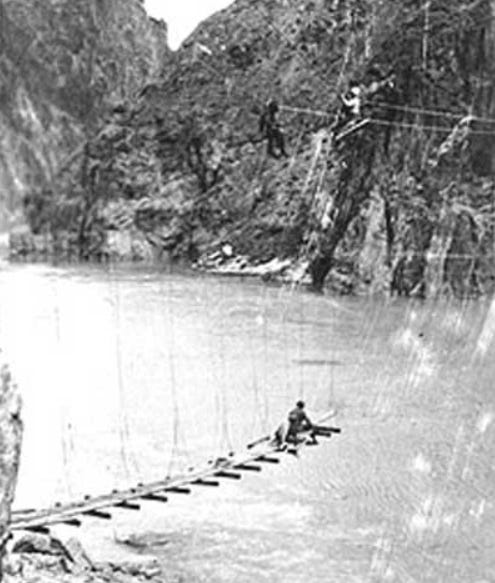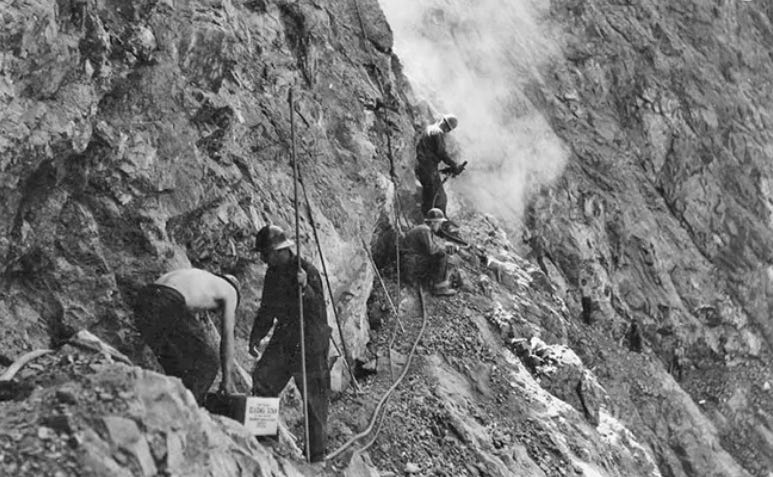After World War I, visitation to the Grand Canyon in Arizona increased significantly and it was made a national park in 1919. With the increase in visitors, National Park Service approved the Fred Harvey Company to build a tourist facility at the bottom of the Canyon in the 1920s. Of course, they tasked architect Mary Colter for drawing up the plans for Phantom Ranch, an oasis at the Colorado River at the bottom of the Canyon. Phantom Ranch's elevation is 2,460 feet; that is about 4,800 feet lower than the South Rim and about 5,800 feet lower than the North Rim.
Rust’s Camp Existed Before Phantom Ranch
Up until the early 1920s, what was known as the Inner Canyon was not easily accessible to most visitors. However, before Mary Colter and the Fred Harvey Company, this area was occupied by a small outpost and tent camp called Rust’s Camp.
David Rust planted cottonwood trees and fruit trees that he irrigated with water from Bright Angel Creek, set up and maintained tents for visiting tourists, and built a ramada for shade (near the current commercial mule corral). Rust’s Camp operated from 1907 to 1919, when Grand Canyon officially became a national park.
Before 1907, the only way to cross the river was by boat, which was dangerous and cost many lives. David Rust built a privately-operated cableway which was a 6 by 10 feet steel cage large enough for one mule or several people to be carried across the river. The cage was suspended 60 feet above the river on a 450-foot-long cable. Gravity propelled the cage halfway across the river. A tram operator cranked a winch on the other side to move the cage the rest of the way. Theodore Roosevelt used this precarious cableway in 1913 while he was on a hunting trip in the Canyon. It is said that enjoyed riding it so much that he did so several times and even cranked the winch that was used to help propel the cage across the river. After Roosevelt’s visit, Rust’s camp was renamed “Roosevelt’s Camp”.

Phantom Ranch
Mary Colter designed Phantom Ranch like most of her other buildings at the Grand Canyon to blend into the natural environment. The ranch consisted of a group of cabins, a large dining hall, and a recreational hall. All materials (except the stones) used in the construction of the cabin complex were hauled down the canyon by mule.
Fred Harvey officials had intended to call the new lodge Roosevelt Chalet, but Colter insisted that if they were to use her plans, they must use the name "Phantom Ranch", taking the name from nearby Phantom Creek and Phantom Canyon.
The Ranch opened on November 9, 1922, and became so popular that in 1925 and in 1927, Colter designed more cabins. These ‘newer’ cabins have less stonework than the originals. The Civilian Conservation Corps (CCC) built the rest of the Phantom Ranch buildings in the mid 1930s. Today’s Phantom Ranch includes eleven guest cabins, four hiker dormitories, an employee bunkhouse and enough room for 92 overnight guests.

Civilian Conservation Corps (CCC)
To help the economy during the Great Depression of the 1930s, President Franklin Roosevelt started the Civilian Conservation Corps (CCC). It had an unexpected positive impact on many public lands across the country, including Grand Canyon National Park. For three years, Company 818, with its crew of nearly 200 enrollees, changed the Phantom Ranch area to make it accessible to more visitors.
CCC workers built the River Trail along the Colorado River, blasting a ledge for the trail into the rock wall. They also improved many other trails, built several buildings around Phantom Ranch, and the first trans-canyon telephone line.
In 1934, the CCC even built a swimming pool. However, as usage increased, it became a maintenance and health nightmare. In 1972, the pool was filled in. If local legend is true, crews tossed hand carved doors, oil-burning stoves, grills, blacksmithing materials, a piano, and a pool table into the space before it was filled in.
Bridges Across the Colorado River
Crossing the Colorado River is essential to reach Phantom Ranch from the South Rim. Currently there are two suspension bridges across the river just a few yards from one another and are the only crossings for hundreds of river miles in both directions.
Previously, we learned about Rust’s cableway across the Colorado River (1907). After Grand Canyon became a national park in 1919, it was decided that a wooden suspension bridge would be built to replace the cableway.

On windy days, this bridge could flip over completely so in 1928, the NPS deemed this “swinging” bridge faulty and built a sturdier replacement.
The Black Bridge (also known as the Kaibab Suspension Bridge), completed in 1928, is the main route for mule and hiker traffic between the South Kaibab Trail from the South Rim and the North Kaibab Trail from the North Rim. It spans about 416 feet and is just 5 feet wide. Mules carried most of the 122 tons of materials for the construction of the bridge into the canyon. However, the one-ton, 550-foot- long suspension cables were carried down into the canyon on the shoulders of 42 Havasupai tribesmen who walked single file down the trail carrying the cables.

In the late 1960s a second crossing was built. The Silver Bridge is located short distance downstream from the Black Bridge and connects the Bright Angel Trail from the South Rim to Phantom Ranch and the North Rim. Only hiker traffic may cross this suspension bridge (no mules). The Silver Bridge is also the support structure for the trans canyon water pipeline. The water pipeline is an amazing engineering feat that pipes 500,000 gallons of water a day from Roaring Springs near the North Rim down Bright Angel Canyon through Phantom Ranch, across the Colorado River suspended from Silver Bridge and then pumped up to the South Rim tourist area. It’s hard to believe that the water used at the South Rim has come all the way from a spring near the North Rim.

How to Get to Phantom Ranch
Arriving at Phantom Ranch is no easy feat. It is located at nearly 4,600 feet below the South Rim and can only be accessed by foot, mule, or boat. Because of the elevation difference, the temperature down at Ranch has reached 120 degrees F during the summer months.
If you plan on visiting, much research and preparation are needed.
Information about mule trips to Phantom Ranch can be found here.
Phantom Ranch Lottery
During Easter weekend in 1964 nearly 1000 hikers arrived at the Ranch with the intention of spending the night, leading the National Park Service to finally establish a reservation system for the Ranch. Currently, a lottery is in place to be able to get accommodations at Phantom Ranch. The following general rules are provided by Xanterra (the concessionaire that runs the Ranch):
Lottery entries are made between the 1st and 25th of the 15th month prior to the desired stay month.
Lottery submissions will be processed, lottery winners notified, and reservations guaranteed within the 14th month prior to arrival.
Any unsold/unclaimed inventory will be released to general availability for reservations following the current 13-month reservation window.
It’s quite a process and lots of prior planning is required. Unfortunately, fewer accommodations are available currently. The dormitories were closed in March 2020 due to COVID, but they remain closed due to the ongoing work on the sewage treatment plant. It seems that the treatment plant requires upgrading and they are keeping the dormitories closed to lessen the number of people using the facilities.
To find out more information about the Phantom Ranch lottery can be found here.
Next Time
My string of Fred Harvey/Mary Colter posts have continued on for a while now and I have just one more. The subject ties both Fred and Mary together. The Fred Harvey Company had Mary Colter design a set of dinnerware to be used in one of the famous dining cars on the Santa Fe Railway. They are now used in the El Tovar Hotel at the Grand Canyon and are currently being produced here in my current hometown of Tucson, Arizona. They are truly beautiful.










Thank you Jan! I know the room intriguing piece About the American South West. I know when my next visit there nice day will be much more in Riched by your writings! I can’t wait to read the next one.
Wow, what a trip into the memory hole. The first time I came across the Grand Canyon must have been in the 70's. I lost my job in New Orleans and traveling west and north just to see what's what.
When I first got there the view was so vast, like nothing in my lifetime; I couldn't make it out. I couldn't locate the black canyon from the rim, stared at it all day. Where was the river down there in all that mosaic? I had no backpack or nothing, just some sturdy shoes. I wrapped up some stuff in a poncho, roped it over my shoulder and headed down. I was so hot when I reached the bottom I jumped right into the river, and it was so completely cold, I shot out of it like a spring. That was Phantom Ranch for me.
After a day or so I made my way up. I still didn't have a backpack, but I bought as much stuff as I could carry and put it into an army laundry bag, again roped up some arm straps and headed down for a week or more. It was as heavy as I could carry and much more difficult making it down.
I could tell you some encounters down there that are just unbelievable, but I don't want to spin too many yarns.
Later in life I made it back to the canyon several times, including a long trip in the Hermit trail basin.
.